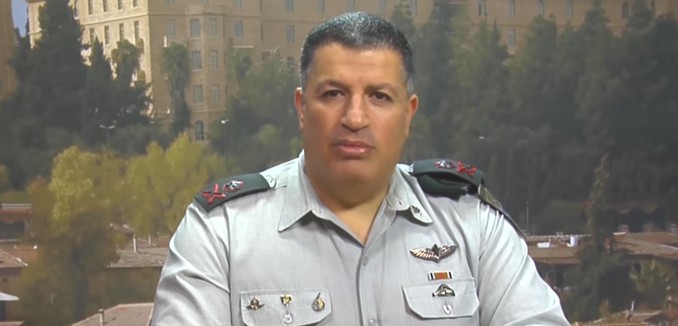Militants from the Palestinian terrorist group Hamas are fighting alongside the Islamic State in the Sinai Peninsula, while ISIS fighters are continuing to receive treatment in Gaza hospitals, a senior IDF official told Palestinian media.
Maj.-Gen. Yoav Mordechai, the coordinator of government activities in the territories, specifically cited a Salafi militant named Mahmoud Z. who has allegedly been coordinating between the two Islamist groups, as well as Ibrahim Abu Qureia, an ISIS fighter who recently received medical care in Gaza.
Mordechai added that Hamas has been seeking to exploit the Erez crossing on the Israeli border for terrorist activities, and warned that continuing those attempts would negatively impact Israel’s good-faith efforts to help with Gaza’s reconstruction.
Israeli security officials told Ynet on Saturday that Hamas had permitted Salafi leaders from Gaza to travel to Sinai, where the local ISIS affiliate is fighting against the Egyptian military. At least two men—Hamas militant Mohammed Sami Gint and Mahmoud Nimr Abdel Latif Zagrah—left Gaza to fight with ISIS, they claimed. Their comments were made the same day Hamas leaders traveled to Egypt in an effort to repair ties with Cairo, which have deteriorated in recent years.
Egyptian security officials were quoted on Thursday by the Israeli daily Yedioth Ahronot as saying that Hamas was building 3-mile-long “mega-tunnels” into the Sinai. Egypt has been aggressively destroying Hamas tunnels that breach into its territory, and its intelligence service has echoed the Israeli assessment that Hamas is involved in arms smuggling with ISIS-Sinai Province.
Mordechai told the Arabic news site Elaph in February that the same tunnel network that Hamas uses to smuggle arms and explosives into Gaza serves as a crossing for ISIS fighters, which Hamas is treating in exchange for money and weapons. Israeli sources familiar with the situation told Elaph that Israel is keeping Egypt informed of ISIS’s movements in the Sinai and of the group’s relationship with Hamas, and has provided the Egyptian military with aerial photographs of tunnel openings along the Sinai-Gaza border.
Ynet reported in December that Hamas has been funding ISIS-Sinai Province with tens of thousands of dollars per month in weapons sales, and that the IDF was intensifying efforts to collect information on the group after it issued several threats against Israel. ISIS-Sinai Province is believed to have thousands of jihadists in its ranks and receive millions of dollars in aid from funders abroad, giving it the capacity to attack Egyptian targets on a daily basis.
According to Egyptian authorities, Hamas’ logistical support and training was key in facilitating the rise of ISIS-Sinai Province. The ISIS affiliate’s leader, Shadi al-Menei, reportedly met with top Hamas leaders in December in an effort to bolster their coordination.
Al-Menei’s forces carried out a major attack in July against Egyptian troops in the northern Sinai, killing over a dozen. The group also claimed responsibility for striking an Egyptian naval vessel that same month, as well as for rockets fired into Israel’s southern region. An Israeli general confirmed at the time that Hamas was assisting ISIS-Sinai Province through arms smuggling and other means.
Times of Israel journalist Avi Issacharoff similarly characterized the relationship between the groups as one of “close cooperation,” adding that Hamas launched surveillance drones to track Egyptian troop movements near smuggling routes between Gaza and the Sinai. “These routes are vital to Hamas on one side of the border, and Islamic State on the other,” he explained.
The widening coordination between the terrorist organizations echoes Israeli Prime Minister Benjamin Netanyahu’s observation in his 2014 speech to the United Nations General Assembly that “ISIS and Hamas are branches of the same poisonous tree.”
Arik Agassi wrote in The Tower Magazine in January that ISIS-Sinai Province “has become one of the most powerful, dangerous, and effective in the region,” largely due to Iranian support via its proxy, Hamas.
The Iran-Hamas-ISIS axis is part of Iran’s strategy of using proxy forces against U.S. allies like Egypt and Israel as part of a larger strategy to achieve hegemony over the Middle East. This has resulted in one of the region’s best kept secrets: An intensive cooperation mechanism between Iran, Hamas, and ISIS, based on money, weapons, military equipment, and training.
Iran’s foreign policy goal of hegemony over the Middle East is based on its primary ideological pillar – exporting the Islamic Revolution to other countries using terrorism and political subversion. In pursuing its ambitions, Iran has often put aside its religious differences with radical Sunni groups like ISIS and Hamas. The Islamic Republic is more than willing to cooperate with these groups as long as doing so helps promote its larger interests.
“By directly supporting Hamas in Gaza and indirectly supporting ISIS in the Sinai, Iran is able to gain foothold against Israel and Egypt to destabilize them, undermine America’s regional influence, create another Iranian power base in a Sunni-dominated region, and project its power and influence in its pursuit of regional hegemony,” Major (res.) Dan Feferman, a former senior IDF intelligence officer and Iran specialist, told the Tower. When asked why Iran would indirectly fund a serious rival such as ISIS, Feferman said that Lebanon, Iraq, and especially Syria are more important to Iran than the Sinai, as Iran wants to preserve its influence in states affected by the Syrian civil war – so Iran fights ISIS in those counties. In places where Iran does not have a strong influence, such as Egypt, it feels comfortable supporting ISIS, albeit indirectly.
[Photo: cogat / YouTube ]




